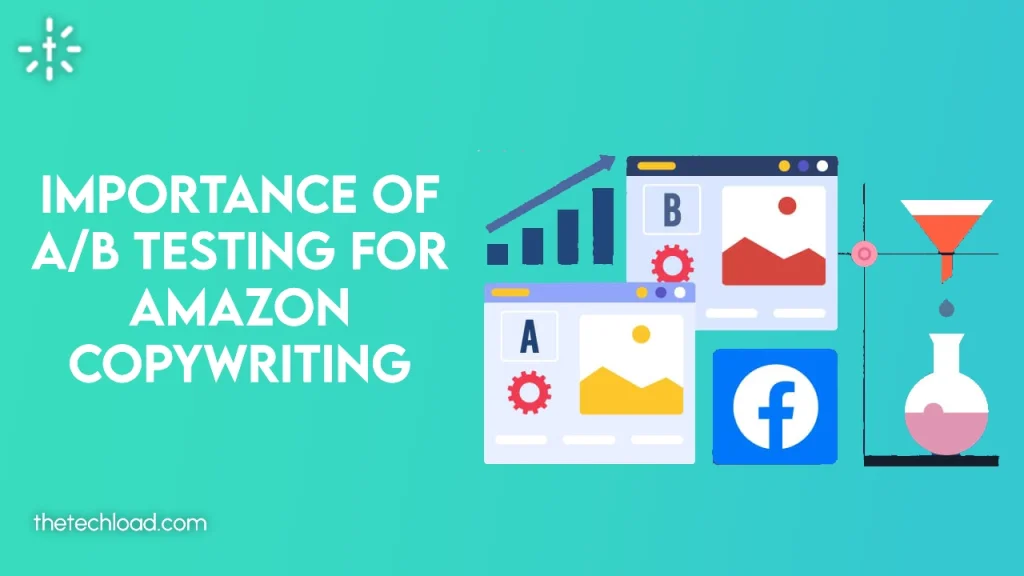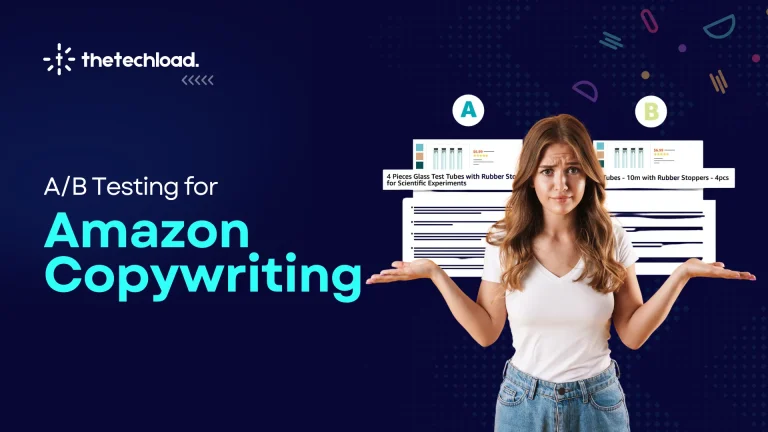Selling on Amazon requires more than a single approach. What works for one brand may not work for another. Even if you’re offering the same product as a competitor, pricing, images, or copy differences could make their listing more appealing. That’s why A/B Testing for Amazon Copywriting is crucial; it helps you discover what resonates best with your customers.
Building a successful listing requires ongoing effort; it’s not a “one-and-done” task. You can identify which versions resonate most with your audience by experimenting with various elements, such as titles, descriptions, and calls to action. This approach removes the guesswork and allows you to make more informed decisions.
A/B testing for Amazon copywriting gives you useful insights, helping you improve your listings based on what real customers do. Are you ready to find out which changes can increase your conversions? Let’s look at how A/B testing can make your Amazon business succeed.
What is A/B Testing for Amazon Copywriting?
A/B testing for Amazon copywriting is a method that helps sellers compare different versions of their product listings to see which elements get more customers to buy. By testing different titles, images, descriptions, and prices, sellers can determine what works best for attracting buyers.
In A/B testing, sellers create two or more versions of a specific part of their listing and check which performs better based on important numbers like conversion rates, click-through rates, and total sales.
For example, a seller might try different product titles to see which one gets more clicks or test various images to determine which pictures lead to more sales.
Sellers can use A/B testing in several areas of their listings, including:
- Product Titles: Trying out different titles to see which grabs more attention.
- Product Images: Testing various main photos to determine which images customers like best.
- Product Descriptions and Bullet Points: Changing the wording or format to see which version leads to more purchases.
- Pricing: Trying different prices to find the best one to increase sales.
To do A/B testing on Amazon, sellers must run each version of their listing separately for a set period because they can’t test multiple versions simultaneously unless they are part of Amazon’s Brand Registry. This method helps sellers make smart choices based on real data, leading to better listings and more sales.

Importance of A/B Testing for Amazon Copywriting
A/B testing for Amazon copywriting is crucial because it allows sellers to make informed decisions that significantly improve their product listings and increase sales.
By testing different elements, sellers can identify what resonates with customers and optimize their listings for better performance.
Here are a few examples to illustrate the importance of A/B testing for Amazon copywriting:
- Improving Click-Through Rates with Product Titles:
A seller has two versions of a product title: “Wireless Headphones with Noise Cancellation” and “Noise-Canceling Wireless Headphones Premium Sound.” By conducting A/B testing, the seller discovers that the second title has a higher click-through rate.
This indicates that potential buyers are more attracted to premium sound quality, leading the seller to use that title for better visibility and sales.
- Enhancing Conversion Rates with Product Images:
A seller offers a backpack with two main images: one showing the backpack on a plain background and another with a model wearing it outdoors.
After running an A/B test, the seller finds that the image with the model results in a significantly higher conversion rate. This suggests that customers prefer seeing the backpack in use, leading the seller to update the main image to maximize sales.
To learn more about creating effective visuals that drive sales, check out our guide on how to create Amazon product images.
- Optimizing Descriptions for Engagement:
A seller tests two different descriptions for a kitchen gadget: one that focuses on its technical features and another that tells a story about how it makes cooking easier and more enjoyable.
A/B testing reveals that the storytelling version engages more customers and leads to higher conversions. This shows the power of emotional connection in copywriting, encouraging the seller to adopt a more engaging style.
To dive deeper into crafting compelling product descriptions, check out our article on What is a Good Product Description on Amazon.
- Finding the Best Price Point:
A seller experiments with two different pricing strategies for a skincare product: one at $24.99 and another at $19.99. A/B testing shows that the lower price leads to significantly more sales, indicating that the price point is crucial in attracting customers. With this knowledge, the seller can adjust pricing to optimize sales and profitability.
5. Improving Customer Engagement:
A/B testing can enhance how engaging a product listing is. By experimenting with different formats for bullet points, like listing features versus telling a story about the product’s use, sellers can determine which format keeps customers interested.
For instance, if storytelling engages more customers and leads to higher conversion rates, the seller can use this format consistently in their listings.
Common Strategies: A/B Testing for Amazon Copywriting
Sellers can employ various A/B testing strategies to optimize product listings on Amazon. These strategies allow sellers to identify what elements resonate most with their audience and drive conversions.
Here are some of the most effective strategies for A/B testing in Amazon copywriting:
1. Testing Product Titles: A/B Testing for Amazon Copywriting
A/B testing product titles is crucial because the title is often the first thing customers see. A well-crafted title can significantly influence click-through rates and conversions.
When testing product titles, consider experimenting with the following:
- Keywords: Try incorporating different relevant keywords that potential buyers may search for. For example, compare “Bluetooth Headphones” with “Wireless Bluetooth Headphones with Noise Cancellation” to see which attracts more clicks.
- Length: Test varying title lengths to find the sweet spot. A shorter, catchy title might work better in some cases, while a longer, more descriptive title might perform better in others.
- Phrasing: Experiment with phrasing styles, such as using questions versus statements. For example, “Are You Ready for the Best Sound?” vs. “Experience Exceptional Sound Quality.”
2. Testing Product Descriptions: A/B Testing for Amazon Copywriting
A/B testing product descriptions helps determine which format and style resonate best with customers. To conduct these tests, focus on the following elements:
- Format: Test different formats, such as bullet points versus paragraphs. Bullet points can make key features stand out, while descriptive paragraphs provide a more engaging narrative.
- Length: Try testing short, concise descriptions against longer, more detailed ones. Some customers prefer quick, straightforward information, while others appreciate in-depth explanations.
- Style: Experiment with different writing styles, such as formal versus conversational tone. For instance, compare a technical description with a friendly, relatable one to see which connects better with your audience.
3. Testing Bullet Points: A/B Testing for Amazon Copywriting
Bullet points are essential for highlighting key features and benefits. A/B testing can be applied to bullet points in the following ways:
- Features vs. Benefits: Test bullet points that emphasize product features (e.g., “Water-resistant up to 50 meters”) against those that highlight benefits (e.g., “Stay dry and worry-free during your adventures”). This helps determine which approach leads to higher conversions.
- Formatting Styles: Experiment with different formatting styles, such as using emojis or varying the length of bullet points. Shorter bullet points may create a sense of urgency, while longer ones may provide more detail.
4. Testing Images and Visuals: A/B Testing for Amazon Copywriting
Images and visuals play a significant role in attracting customers and influencing their purchasing decisions. A/B testing can be applied to images and visuals in several ways:
- Different Images: Test various images of the product, including lifestyle images that show the product in use versus plain product images. For example, compare a photo of a dress on a model in a scenic location with a simple image of the dress on a white background.
- Image Quality: Experiment with image quality, such as high-resolution images versus standard quality. Higher-quality images may lead to increased trust and engagement.
- Infographics: Consider testing infographics that highlight key product features or benefits. Infographics can make complex information more digestible and visually appealing to potential buyers.
Tools and Resources for A/B Testing on Amazon
Conducting A/B tests effectively requires the right tools and resources. Here are some popular options that Amazon sellers can use:
- Amazon’s A/B Testing Tool: Available through Amazon’s Brand Registry, this tool allows sellers to create and test multiple versions of product listings to see which performs better.
- Splitly: This tool gives sellers insights into optimizing their Amazon listings through A/B testing and other data analysis features.
- Helium 10: Helium 10 offers tools to help sellers improve their product listings, including A/B testing capabilities, keyword tracking, and listing optimization features.
- Jungle Scout: This tool provides insights into market trends and helps sellers optimize their listings, including A/B testing for various elements.
By utilizing these strategies and tools, Amazon sellers can effectively enhance their product listings, improve customer engagement, and drive higher conversion rates through informed decisions based on A/B testing results.
The Impact of Split Testing on Sales: A Case Study Example
In this case study, we’ll explore how a simple change in product copy can significantly boost sales through split testing. The product in question is a gadget priced at $30, with an initial conversion rate of 15%. The goal was to determine whether updating the product description could lead to better sales performance.
Phase 1: Baseline Performance
The seller kept the original product description unchanged for the first two weeks to establish a baseline. During this period, key metrics, such as product views and conversions, were carefully monitored.
- Views: 800 views over two weeks
- Conversion Rate: 15%
Using these numbers, here’s how the sales and revenue were calculated:
- Sales: 15% of 800 = 120 sales
- Revenue: 120 sales x $30 = $3,600
This data represents the seller’s typical performance without any changes to the listing.
Phase 2: Split Test with Updated Description
After the first two weeks, the seller updated the product description to a more engaging, customer-focused version designed to resonate better with potential buyers.
This new description was tested for the next two weeks while keeping other listing elements constant.
- Views: 800 views over two weeks (unchanged from Phase 1)
- Conversion Rate: Increased to 18%
The results after updating the description were clear:
- New Sales: 18% of 800 = 144 sales
- New Revenue: 144 sales x $30 = $4,320
Results: Increased Revenue and Sales
The seller gained 24 additional sales in just two weeks by updating the product description. This resulted in a significant boost in revenue:
- Revenue Increase: $4,320 – $3,600 = $720 in extra sales over two weeks
If this conversion rate improvement continues, the seller could generate an additional $1,440 in monthly revenue. This case study illustrates the direct financial impact of small, targeted changes like updating product descriptions on overall sales performance through A/B testing.
Conclusion
A/B Testing for Amazon Copywriting is a powerful strategy to help sellers optimize their listings by identifying what truly resonates with customers. Whether you’re testing product titles, descriptions, or images, the insights gained can improve conversion rates and increase sales. By continuously refining your listings through split testing, you can stay ahead of the competition and maximize your Amazon business potential.
If you’re ready to take your Amazon listings to the next level, The Techload can help. With expert guidance in A/B testing and Amazon optimization, we’ll fully optimize your listings to drive more sales and success. Let’s get started!
A/B Testing for Amazon Copywriting: FAQs
What is A/B testing, and why is it important for Amazon copywriting?
A/B testing involves comparing two versions of your product listing to see which one performs better. It’s crucial for Amazon copywriting because it helps optimize elements like titles and descriptions, improving conversion rates and sales.
How can I conduct A/B tests on my Amazon product listings?
You can run A/B tests by creating different versions of your listing, such as changing titles or images, and then tracking key metrics like conversion rates. Tools like Amazon’s “Manage Your Experiments” make this process easier.
What are the key elements to test in Amazon product titles?
Test different keywords, title lengths, and phrasing styles. These variations can help you identify which title attracts more clicks and conversions from potential buyers.
How do I know which version of my copy is performing better?
Use key metrics like conversion, click-through, and sales to determine which version performs better during the A/B test. The version with higher engagement wins.
Are there any free tools available for A/B testing on Amazon?
Professional sellers enrolled in the Amazon Brand Registry can use the free “Manage Your Experiments” tool. This feature allows you to test different versions of your content, helping you optimize your product listings by identifying which changes boost customer traffic and sales.
How often should I perform A/B tests on my Amazon listings?
It’s recommended to run A/B tests periodically or whenever you introduce new products, keywords, or visual changes. Regular testing ensures your listings stay optimized for current customer preferences.





